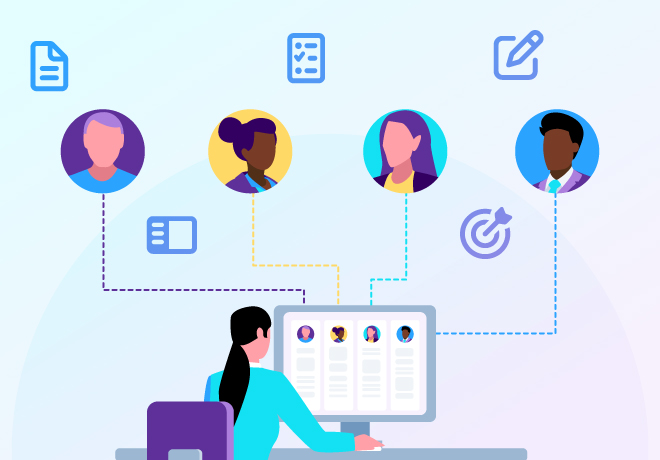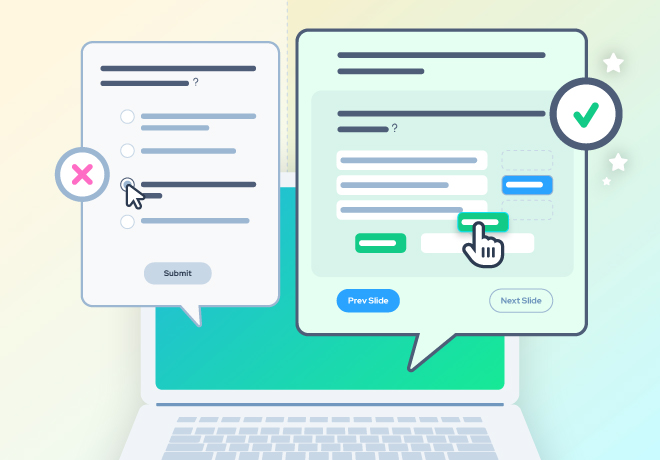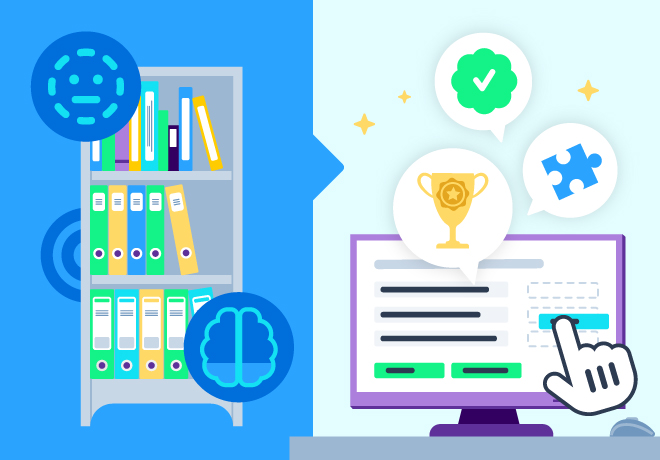
5 essential stages of online training maturity

Related articles
Get valuable eLearning insights to your inbox.
Listen to Neovation’s Demystifying eLearning podcast generated with NotebookLM!
Listen to our podcast on your favorite platform!
Companies with mature training models generally incorporate online training. And moving some or all employee training from an in-person, instructor-led training (ILT) model to a partially or fully online approach seems like a logical step: Many organizations were forced to move online during the pandemic, but in some cases, this pivot merely accelerated a plan that was already in the works. Other organizations are embracing hybrid or fully remote work models that mean fully in-person ILT is no longer feasible.
And effective online training has a proven track record. It works because:
- It’s flexible and available wherever learners are. With on-demand access, learners can use the training materials more often and more easily.
- It’s easy to localize for global learner audiences, target by job role, scale up as your organization grows, and adapt to your organization's evolving needs in other ways.
- You can extend training beyond employees to suppliers, customers, franchisees, contract and gig employees — the entire extended enterprise.
- Online training removes many barriers that keep learners from fully engaging with learning and development opportunities at work, whether because you use technology to overcome barriers posed by learners’ disabilities or because easy online access removes barriers like scheduling conflicts and lack of travel budgets to attend in-person courses.
When training is easier for learners to access and use, they are likely to engage with it more often. This generally means that they retain the information, apply it on the job, and change their behavior — all outcomes that improve performance. All of that adds up to a more strategic and effective level of training maturity.
Neovation Learning Solutions recognizes that organizations are at different stages in the move to online training and recommends a five-stage approach to achieving online training maturity, or a robust, performance-driven online training ecosystem. The five-stage approach enables organizations to plan strategically, advance to a new stage once they’ve achieved clear goals in their present stage, and formulate an online training roadmap that makes sense for their budgets, staff, and learner populations.

1. The training audit
What this means
Not every organizational problem is solved by training. Sometimes, providing performance support tools or encouraging collaborative brainstorming would be a better solution. So, rather than responding to every performance problem by ordering a training course, we recommend performing a training audit.
The audit looks at the entire organization’s existing and planned training, examines its needs and goals, and provides the blueprint for planning online training, performance support, and other resources in a strategic way. A training audit and strategic online training plan can identify and address all of your organization’s knowledge, performance support, upskilling, and reskilling needs in a logical and effective way.
How to implement it
We recommend calling on an external learning consultant or instructional design consultant to perform a training audit, rather than conducting one with in-house personnel. This professional will examine your needs and any existing training, bringing an outside perspective that captures a big-picture view of your organization’s needs. A professional consultant will have the broad and deep knowledge needed to explore new solution paths — and they are not hobbled by attachment to how things are currently done or wanting to use familiar tools and methods.
By figuring out what is working and what is not and inventorying your content, the online training consultant is able to create tailored recommendations for your organization.
The end product of a training audit is a strategic plan for training your employees. The plan might recommend the purchase or creation of specific training materials or tools. It will also consider performance support and knowledge retention needs and include recommendations for nurturing a learning culture. The strategic plan is a guide to designing and implementing the most effective eLearning ecosystem for your organization to meet your unique needs and goals.
2. Transition ILT to online training
What this means
Many organizations are accustomed to doing much or all of their training using instructor-led training (ILT), in live face-to-face sessions. This might cover onboarding and compliance training, introducing new products and services to sales or support personnel, or teaching power-skills or any other topic.
Converting some or all of this instruction to online training might move it to digital synchronous training, where learners and instructors interact, to asynchronous learning, which learners complete independently and on their own schedule.
Online synchronous training refers to virtual instructor-led training (VILT) in interactive virtual classrooms and other formats, like webinars, with varying amounts of interaction among learners and between the learner and the instructor. Asynchronous online training is available in dozens of formats and approaches, from eLearning modules to videos, podcasts, microlearning, game-based learning, and more.
How to implement it
Your organization might use an on-site or cloud-based learning management system (LMS) to house your online training modules and handle enrolling and tracking learners and their progress. Your LMS might also be able to track some virtual learning, such as virtual classroom sessions and webinars, and handle enrollments for these courses. If you don’t already have an LMS, your L&D team will need to choose one. The team making the LMS purchase decision might include the consultant who helped with your training audit, as well as a project manager, training admin, designer or developer, and others.
Your LMS is likely to offer a search function and allow learners to browse course offerings and resources. Learners might select training courses or be assigned, either by their managers or by training administrators, to training that is required or beneficial for people in their job role. Your LMS might support internal certifications, learning paths, career pathing, and competency management for succession planning.
You might also choose to use an authoring tool to create online training modules and other forms of digital training content. These can include gamified microlearning, learning games, videos, podcasts, eBooks, animations, and immersive scenarios. Providing online training content in a variety of formats and providing interactive activities where learners can apply what they are learning provides a rich and effective learning experience.
3. Support performance in the workflow

What this means
After bringing in new training tools to meet basic training delivery needs, some organizations realize that they can use those tools in other ways as well. In other cases, the training audit recommends tools other than — or in addition to — training to support better performance and efficiency.
Many organizations that are at this intermediate stage of training maturity seek to develop and support improved worker performance. Or they recognize a need for refreshers and problem-solving outside of formal training courses and events and provide resources and tools to support this informal and ongoing learning.
Learners increasingly indicate a preference for self-directed learning activity that takes place within their workflow, rather than relying on scheduled training sessions.
A trend toward encouraging continuous learning, as well as collaborative and social learning among colleagues and teams, has more organizations providing self-directed learners with options, resources, and support for deepening their knowledge and solving problems they encounter on the job.
How to implement it
Delivering learning and performance support materials in the workflow requires a different approach from scheduling training sessions. As more employees work remotely, or are in roles where they don’t have easy access to computers and classrooms, it becomes more challenging to reach workers and learners wherever they happen to be at the moment they need access.
That’s why many organizations implement workflow learning using mobile training platforms and formats like microlearning that deliver short, focused lessons, rather than 30- or 60-minute training modules or webinars. Organizations seeking to encourage self-directed, collaborative, or social learning might provide a knowledge base, a curated content site, and social and collaborative learning platforms, such as Microsoft Teams or Slack, or discussion boards.
These focused, on-demand resources also support employees’ performance by offering immediate access that reminds learners of how to do infrequent tasks and processes, ensures that they have current information when they need it, and enables them to review training content quickly. Your L&D team can develop workflow learning materials in-house, adapt existing training to the format, purchase off-the-shelf products from a vendor, or ask an expert eLearning design team, like the one at Flare Learning, to help.
4. Adopt a knowledge-retention strategy
What this means
Providing easy access to the training and resource materials that learners need is a great start, but to eliminate knowledge gaps and improve on-the-job performance, organizations also need to build long-term knowledge retention. Building retention requires repeated exposure to essential content over time, so that learners remember what they have learned and can recall and apply it on the job.
This stage of training maturity often entails embracing an ongoing “continuous learning” strategy, requiring a cultural shift from the conventional “annual” training approach.
How to implement it
At this stage, organizations might adopt an adaptive delivery platform for their training content, commonly known as an adaptive microlearning platform.
Adaptive training delivery recognizes that each learner has a unique combination of background knowledge and experience, as well as individual job goals and varying needs for expertise. An adaptive training platform delivers unique content to each learner, which represents a significant paradigm shift from the typical approach of delivering the same content to all learners, whether in person or online.
Adaptive training delivery is a good choice for knowledge-retention campaigns because it is engaging to learners. Since all of the content they see is highly relevant, they are more likely to spend time with their training; and more time spent training leads to better long-term retention and better job performance.
Adaptive microlearning platforms might also build engagement using gamification: applying game elements and mechanics — levels, points, increasingly difficult challenges, leaderboards, or contests — to learning content. The goal is to motivate learners to constantly improve, whether through competition with colleagues or “competing” against their own past performance.
5. Focus on performance-driven training

What this means
Adopting a performance-driven training strategy is a proven way to ensure that your training is an investment, not just an expense. It means identifying specific business outcomes, also called Key Performance Indicators or KPIs, that you want to improve; targeting training to those metrics; and using data to determine whether your training interventions actually improve those KPIs. That shifts the focus from how many learners have completed a training module or what each learner’s quiz score was to whether and how the training is improving learners’ on-the-job performance.
How to implement it
To implement a performance-driven training strategy, you must first identify and track KPIs that impact your business success, such as sales data, customer satisfaction scores, or health and safety incidents.
Then, you need to figure out which on-the-job behaviors are related to those KPIs — and design training that will align learners’ behaviors to best practices. This might require input from executives and middle managers, as well as online training design and development experts.
Performance-driven training is generally tracked and measured, and you can evaluate your progress using a business intelligence (BI) platform, such as Microsoft PowerBI. These tools enable you to create dashboards and data visualizations that show the KPIs and your training data, as well as any correlations between them. Your BI platform will likely facilitate creating reports and graphs for learners’ managers or for corporate leaders as well, making it easy to illustrate any correlations between training progress and job performance.
Consult with the experts
You are now armed with a new understanding of the steps and stages toward achieving training maturity as you move from an ILT-based training approach to an online training ecosystem. Now is a good time to examine where your organization is on the training maturity path, what your online learning and business goals are — and how an online training strategy could help you accomplish those goals.
Your next step might be to consult with an expert learning consultant about how to get started with your training audit. Contact us today, and we’ll guide your exploration of the possibilities as you launch your journey to online training maturity.

An experienced writer, editor, tech writer, and blogger, Pam helps you make sense of learning science and eLearning technology. She provides information you can use to drive improvements in your training effectiveness and ROI.
Become part of our L&D community
We publish a new learning hub article — full of useful, practical topics — weekly.
Not sure where where you want to start? Jump into one of our recently published articles and see where it takes you!








-svg.svg)
-svg.svg)
-svg.svg)
-svg.svg)